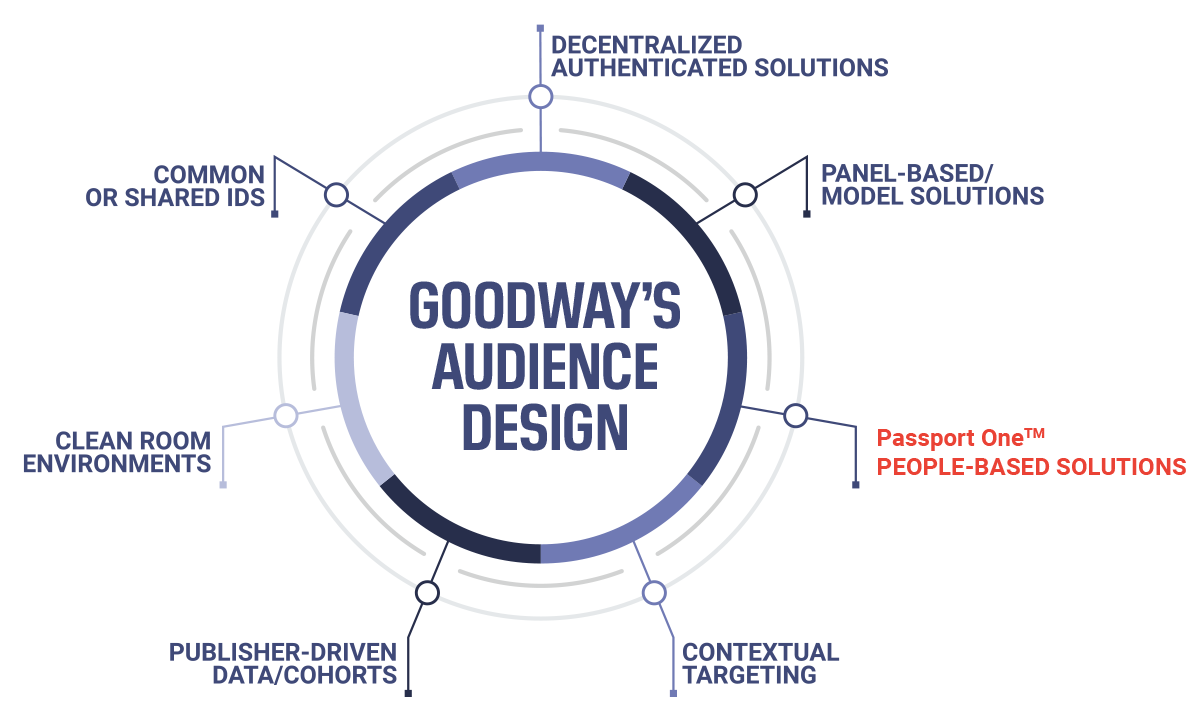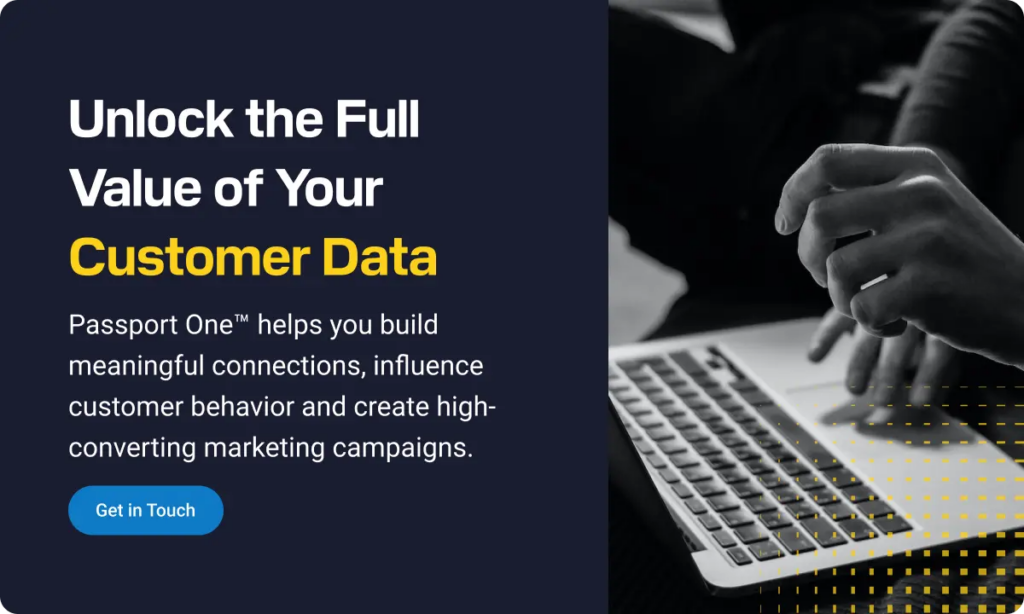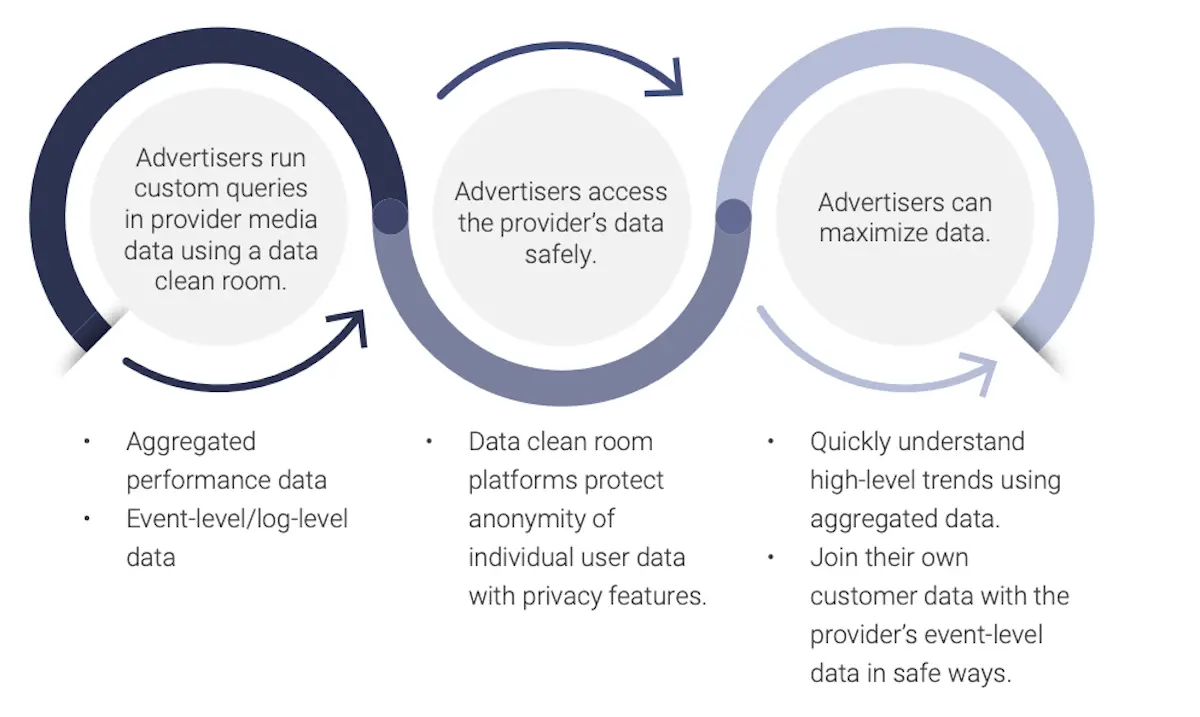The 7 Cookieless Identity Solutions Modern Marketers Use

With Google soon deprecating third-party cookies, it’s never been more important to plan for your cookieless future. Here’s the thing: No one-size-fits-all cookieless identity solution will take its place. But to help you hit the ground running, we’ve created a guide to bring you up to speed on the latest developments.
We’ve also highlighted the seven comprehensive cookieless tracking tools we’ve tested here at Goodway Group that can empower you to maintain targeting and measurement and drive impact in the cookieless world.
Get Your Copy Now: PDF Download
A Cookieless Identity Solution for Every Marketing Challenge
People-based marketing. Contextual targeting. Publisher-driven data/cohorts. Clean room environments.
Common or shared IDs. Decentralized authenticated solutions. Panel-based/model solutions.
Goodway has been implementing each of these cookieless targeting solutions for marketers since the future of identity was put into question.
Now with these solutions compiled in your modern marketing tool kit and with Goodway’s teams of analysts, data scientists and strategists by your side, your brand has the power to maintain targeting and measurement post-cookie-deprecation and solve different challenges in the identity and privacy space.
In this guide, we’ll deliver the answers to your most complex challenges and help ease your uncertainty amid a changing landscape. Here's what’s included:
- Consumer Privacy and Regulations
- Our Tool Kit of 7 Goodway-Tested Solutions
- Glossary of Identity-Related Terms
Understanding the Current Landscape
Digital advertising has heavily relied on third-party cookie data and mobile advertising IDs (MAIDs) for personalization, targeting and measurement — brands must prepare and adapt in order to be successful in a consumer privacy-centric world. With this new digital advertising era on the horizon, several new identity alternatives have already been developed, with many more to come. But how do marketers sort through the options and know the combination of tools and strategies that will best serve them?
First, it’s important to recognize there’s no silver bullet — there isn’t a single solution that solves every challenge for every marketer when it comes to filling the gap left by third-party cookie data. Rather, marketers must assess their goals, strategies and key performance indicators (KPIs) to determine the set of solutions that best meet their needs — while keeping up with changing privacy regulations.
Consumer Privacy and Regulations
Born out of a combination of bad actors and general consumer distrust with government officials desiring to intervene, consumer privacy regulations are here to stay and will continue to become more restrictive.
Understanding Legislative Impacts
Consumer privacy legislation started in the European Union with the General Data Protection Regulation (GDPR) in 2018, and we’ve started to see the United States follow suit via state legislation. California was the first state to issue legislation with the California Consumer Privacy Act (CCPA) in 2021, which was amended to the California Privacy Rights Act (CPRA) in 2023. Over half of U.S. states either have privacy legislation in place or are actively reviewing bills in committee.
Many states seem to use California’s laws as a template, but it’s important to keep up with new laws as they are passed and adapt accordingly. Marketers should develop strategies assuming U.S. states and territories will inevitably enact consumer privacy laws.
In addition to the current EU and U.S. legislation outlined above, we must keep an eye on the more restrictive laws at play globally as they could be used to inform what will ultimately happen within the U.S. Over 70% of countries have some form of data protection and privacy legislation in place.
The bottom line is that marketers today should assume privacy legislation is already in place to prepare to win in the future.
Modern Marketing Tool Kit
With the rash of new technological limitations and privacy legislation efforts, Goodway has put together a comprehensive tool kit consisting of seven different strategies and approaches for succeeding in the cookieless future.
Each of these tools solves unique challenges and requires unique expertise to achieve great results. At Goodway, we know that one size does not fit all when it comes to your unique business challenges. These seven solutions come together to create and empower the modern marketer with:
- Precision targeting
- Endless personalization options
- Unprecedented scale
- Advanced measurement and analytics
Our Tool Kit of 7 Goodway-Tested Solutions
The seven solutions that make up the cookieless tool kit are each unique and solve different challenges in the identity and privacy space. Let’s take a look at each of them in greater depth.

Jump to a solution:
- People-Based Marketing
- Contextual Targeting
- Publisher-Driven Data/Cohorts
- Clean Room Environments
- Common or Shared IDs
- Decentralized Authenticated Solutions
- Panel-Based/Model Solutions
1. People-Based Marketing
To meaningfully connect with your customers and prospects, you need to personalize your marketing and ensure your messages across channels and devices are relevant to them.
As holding companies acquired data providers, we knew Goodway needed to provide marketers with a democratized way to provision and enhance first-party data for any brand, regardless of where they are in their first-party data journey. Out of this, our own people-based advertising solution Passport One was born.
What To Know
People-based marketing (PBM) streamlines an individual’s data scattered across offline and online sources into one persistent (long-lasting) ID that can be recognized no matter the marketing channel, browser or device.
What To Consider
PBM is effective for any industry and gives you the reins to use data-driven advertising to reach and expand your customer base efficiently and effectively.
Having a fuller picture of who your customers are — knowing more about their motivations, intentions and path to purchase — can help you advertise to them (and people like them) with personalized and relevant messages geared to convert. These customer insights can give you the intel you need to make better and faster decisions when planning media and determining the right media mix.
Pinpointing where your customers and prospects are and targeting them across multiple channels and devices at the right time and with the right message means you not only can work more efficiently but also reduce ad waste and improve ROI.
Goodway’s Passport One is a proprietary database that contains information about the hundreds of attributes for 95% of U.S. consumers so you can build audiences from scratch or enhance the view of the first-party data you already have.
What Is Passport One?
Goodway created a customized audience discovery tool set facilitating access to an expansive identity graph and corresponding attributes. Passport One provides best-in-class data access to:
- 300 million consumer profiles.
- 126 million U.S. households.
- Linkage to 500 million email addresses utilizing ID solutions.
- 1,500 individual household-level level attributions.
Passport One is Goodway’s database to identify a marketer’s customers, enhance existing first-party data and create new opportunities for closed-loop measurement. When combined with other components of the tool kit and Goodway’s teams of analysts, data scientists and strategists, brands now have the power to punch well above their weight class and be well ahead of the competition.

2. Contextual Targeting
Contextual targeting technology reviews the content and context of a page and categorizes it so advertisers can decide whether they want to appear next to that content and, if so, how much they’d like to pay for it. The technology has evolved to include semantic understanding, so “club” for a golf club manufacturer would not qualify if the website content were about a dance club.
What To Know
The results of upper-funnel campaigns are typically enhanced by positive, relevant content association. Contextual targeting provides a 100% privacy-safe, legislation-proof way to place ads within context that is desirable for a marketer.
What To Consider
- Contextual signals aren’t reliant on cookies and are strong indicators of performance.
- Contextual targeting has come a long way from its origin, with far more advanced technology advertisers should reconsider.
- Some view contextual as a step backward as this technology has been around for a long time, but it’s quickly gaining relevance again.
- In many instances, measurement is currently centered on cookie-based key performance indicators (KPIs).
3. Publisher-Driven Data/Cohorts
Long thought of as a bridge connecting a publisher to a demand-side platform (DSP), supply-side platforms (SSPs) and other publisher solutions are evolving to connect advertisers to their publishers’ known users. This involves buying the inventory through a third party, whereas authenticated traffic can be bought solely against the matched data.
What To Know
This application is like authenticated solutions but requires deep partnerships and pre-negotiated terms with the largest SSPs. Goodway can provide this quickly and efficiently as part of your planning process.
What To Consider
- You can access valuable publisher first-party data aiming to replace the current third-party cookie data market.
- Publishers know their consumers better than anyone else, making them able to curate better audience targeting than currently available.
- Scale is currently an issue as publishers will need to form cohorts and work together to create scalable solutions for buyers.
- Measurement capabilities are works in progress currently, so while the ability to target successfully is achievable, what measurement looks like is yet to be determined.
4. Clean Room Environments
A clean room brings the best of all worlds to a marketer by bringing raw log-level data into an environment that can be queried for insights, measurement or audience building. The resulting data can be either reported on or pushed back into a buying platform for activation. All of this is done without the marketer ever having to own or store this data on its own servers, or even be exposed to the individual line items. This eliminates privacy concerns while providing marketers rich insights and capabilities.

What To Know
When a marketer wants to answer a question not available in an existing dashboard or report, custom queries must be programmed into platforms to extract these insights. For example, what's the third quartile median frequency of display ads for users who also see at least one connected TV (CTV) ad and later become a paying customer? While this sounds complex, these deep questions and insights allow a marketer to build massive advantages over the competition.
What To Consider
- Data clean rooms are secure and privacy-compliant; there is no access to raw data.
- You can combine first-party data with impression-level data in data clean rooms environments.
- They require all inventory and data providers to participate.
- Data clean rooms also require true data science and analytics experts to build queries and extract value from the platforms.
5. Common or Shared IDs
Multiple solutions are available in the market, including independents and Google, Facebook, Amazon and others (which are only available within their walls). What’s best for your business will not be driven by the ID solution itself but by your business goals and how a given platform or set of tools can best deliver against them. Once you choose the platform, Goodway can quickly help you select your preferred shared ID.
What To Know
As cookies have faded, the industry has moved from thousands of back-end “cookie syncs” to a handful of mainstream stable IDs that can be persistent yet are permissioned and agreed to by users.
What To Consider
- These are open source and available to everyone for free.
- These solutions are independently-governed.
- They are deterministic (known to be true) — based on consumer-provided emails.
- They require publisher buy-in across the web, which could impact scale.
6. Decentralized Authenticated Solutions
These are companies that have helped publishers bring their logged-in user sets together to create a pure stream of authenticated-only (logged-in) traffic.
What To Know
As a marketer, your first-party data represents the user set you know most about: users who are the most valuable, who can be upsold and from which we want to model. Instead of going to each publisher individually, the authenticated solution offers single-source matching across many publishers to grow reach across known users.
What To Consider
- Build upon consumer consent, enabling direct, trusted relationships with users.
- Get deterministic data – based on consumer-provided identifiers.
- Enable data-driven advertising across cookieless inventory.
- The authenticated universe, outside walled gardens, will equate to 20%-30% of available inventory, which creates a valuable solution, but one that doesn’t scale on its own across the entirety of the open internet.
7. Panel-Based Model/Solutions
Like Arbitron radio and Nielsen TV panels of the past, there are many third-party solutions that have built panels of hundreds of thousands of known users. Because each user has consented to have all their online activity tracked, the panels have a 100% view into each user’s activity.
What To Know
Panel-based data is a fantastic guide and way to begin a campaign. While not deterministic across the entire internet user population, behaviors and affinities for the larger internet properties are clear as they relate to common brand categories.
What To Consider
- Uses survey-based data for brand lift measurement.
- They are not reliant on third-party cookies.
- This data only makes up a small percentage of total user base.
- The data used to guide and inform optimization decisions is a challenge.
Glossary of Identity-Related Terms
We've compiled a glossary containing the top cookieless terms to know for quick reference. Check it out below.
Cookies
Small text files that are dropped on a user’s browser (i.e., Google Chrome) by a website when they visit the site. Cookies utilized for digital marketing track data about users, such as their computer’s IP addresses and their browsing activity, enabling the site and other marketers to provide relevant ads to the user and identify and measure the best audiences for their efforts.
Deterministic Matching
Relies on using encrypted personally identifiable information (PII) such as an email address or a phone number to link devices to that identity.
First-Party Data
Data provided or collected directly from an audience or customer in a consented, opt-in manor such as email addresses submitted to a site or brand via an app or website. It can also include data on behaviors, actions or interests demonstrated throughout the consumer journey including website or app activity and online/in-store purchasing.
Hashing and Salting
A data input is transformed into a series of random numbers or letters. Due to the deterministic nature of the hash function, input values that are identical will have identical outputs. “Salting” the hashed values adds an additional numeric layer to ensure the final hash is always unique.
Identity Resolution
The process of collecting and linking anonymous and unique identifiers across devices and touchpoints to build a cohesive, omnichannel view of an individual consumer. This enables advertisers to better understand audiences and match to desired attributes, creating robust customer profiles that allow them to deliver relevant customized content throughout the customer journey.
Open Web
Accounting for approximately 30% of available digital audiences, the open web allows for audience identification, reach and tracking beyond walled gardens such as Google and Facebook, which operate a closed advertising tracking and measurement ecosystem.
Personally Identifiable Information (PII)
Data that can be used to uniquely identify, contact and distinguish consumers. PII can include names, addresses, social security numbers or other identifying numbers or codes, telephone numbers, email addresses, etc. It also includes data intended to identify specific individuals in conjunction with other data elements such as indirect identification (which may include a combination of gender, race, birth date, geographic indicator and other descriptors).
Probabilistic Matching
Uses “soft signals” like device type, software version, screen resolution, OS, location and IP address to build an ID graph for users.
Recognized Identity
Pseudonymous data identifiers that identify someone without explicitly provided consent such as cookies and device IDs. Pseudonymous data is information that no longer allows the identification of an individual without the use of additional information that is kept separate from it. Pseudonymous data differs from anonymous data in that it still allows for some form of re-identification while anonymous data cannot be re-identified.
Single Sign-On (SSO)
Enables users to log in across multiple domains using a single ID (most commonly an email address).
Third-Party Data
Data purchased from outside sources that aren’t the original collectors of that data. In digital, third-party data is information collected by an entity that doesn’t have a direct relationship with the user on the platform or site where data is captured. It’s often collected from a variety of websites and platforms and aggregated by a third-party data provider such as a data management platform (DMP). These aggregators pay publishers and other data owners for their first-party data.
Are You Prepared for the New Era of Digital?
Developing a strategy to lead and thrive in tomorrow’s identity landscape requires careful planning and expertise. Goodway is here to help. Contact us to schedule an assessment with one of our identity experts and discuss which solutions make the most sense for your company or clients.
Looking for the answers to your cookieless questions? Here are some other helpful resources:





